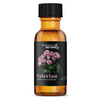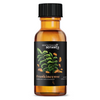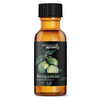
A Complete Guide to Valerian Essential Oil Benefits
One of the first mentions of the valerian root in the context of neurological disorders was in a 16th-century botanical work called “Phytobasanos.” It was written by Fabio Colonna, an Italian botanist and naturalist who suffered from epilepsy. In his search for herbal anti-epileptic drugs, he came across valerian root powder and found it effective as an anticonvulsant.
Despite the publication of this information in botanical works, valerian root did not gain traction for therapeutic use until much later. Writers who succeeded Colonna also reported the anticonvulsant effects of valerian root, prompting scientists to examine its interactions with the neurological system.
While modern research does not show much support for its anti-epileptic effect, studies have uncovered other therapeutic uses of valerian. Currently, valerian root herbal drugs are prepared in the form of extracts, supplements, teas, and essential oils. Valerian essential oil contains biologically useful volatile compounds and is one of the more researched and chemically consistent forms.
This article further expands on the chemical properties and restorative benefits of valerian root essential oil, and how you can use it for health and wellness.
Historical Use of Valerian Essential Oil

The earliest therapeutic use of drugs prepared from valerian root can be found in ancient Rome and Greece. In Europe and Britain, these therapeutic drugs were referenced as ‘Valerian’ in formulatories and pharmacopoeias. In other parts of the world, such as India, South Africa, China, and Japan, extracts from valerian root were used in tranquilizing and sedative preparations.
Apart from this, valerian was used to treat anxiety, hysteria, nervousness, headaches, and nervous indigestion. All of these uses markedly stem from an effect on the nervous system, and perhaps in recognition of this, valerian was also widely known as the ‘Nerve Tonic.’
Valerian Root Essential Oil Extraction and Processing
Valerian root oil is an essential oil that is steam distilled from the rhizomes or roots of the Valeriana Officinalis plant, a species of small herbaceous perennial. It belongs to the Caprifoliaceae or the honeysuckle family of plants, consisting of flowering plants native to North America and Asia. Valerian plants grow to heights of between 1 to 2 meters and have white or pale purple flowers. It is mainly cultivated for medicinal use and can adapt to environments that are not native.
When extracted, valerian root essential oil appears clear and has a warm, woody scent with earthy characteristics. It blends well aromatically with grapefruit, lavender, petitgrain, and chamomile essential oils.
Where Do Valerian Essential Oil’s Therapeutic Effects Come From?
Valerian root essential oil is highly valued for its concentration of sesquiterpenes, flavones, and valepotriate compounds. Although there is no scientific consensus on the exact ratios or number of compounds, it is known to contain between 50 to 100 chemical compounds, most of which are biologically relevant. This can be attributed to the fact that the chemical composition of valerian root species differs significantly based on external factors such as soil and temperatures.
When using valerian essential oil for therapeutic reasons, it’s important to work with a supplier who is transparent and safety-focused, like Wholesale Botanics, so you can trust in the quality of the oil.
Terpenes
Valerian root oil consists of monoterpenes and sesquiterpenes, compounds that differ slightly in their structure and properties. The terpenoid compounds isovaleric acid and bornyl isovalerate are primarily responsible for the characteristic balsamic woody aroma of the essential oil.
On the other hand, a sesquiterpenoid compound called valerenic acid produces the most notable pharmacological effects. It is a compound unique to the chemical composition of valerian root preparations and contributes to its novelty in natural therapy. A study investigating the activity of valerenic acid found that its therapeutic effects are focused on the central nervous system, affecting the brain and nerves instead of the body.
The key mechanism involved in valerenic acid’s sedative effects is its ability to reduce the breakdown of gamma-aminobutyric acid (GABA) in the brain. GABA is a neurotransmitter that plays an important role in calming and relaxing the nervous system. Increased levels of GABA in the brain result in relaxation and reduced anxiety.
As a result of this mechanism of action, the pharmacological activity of valerian root oil is often compared to benzodiazepines, a class of drugs known as depressants. All of the medicinal effects attributed to benzodiazepines are caused by interaction with GABA levels in the nervous system.
Valepotriates
Valepotriates are iridoid-like compounds that were first isolated in 1966. They are exclusively found in extracts of the Valeriana Officinalis species and are studied for their tranquilizing effects and usefulness in reducing restlessness, anxiety, and aggressiveness.
These compounds are found to interact with dopamine receptors by binding to them, potentially reducing the excitatory effects of dopamine on the central nervous system. This means that valepotriates may potentially have a calming effect by inhibiting dopamine activity, a hormone that has stimulatory effects.
Flavones
Research in the early 2000s uncovered two previously undiscovered flavonoids in valerian root extract, namely 6-methylapigenin and hesperidin. These compounds were found to affect the central nervous system, contributing to valerian root's anxiolytic and relaxing properties.
A 2003 study related that 6-methyl apigenin was a ligand for benzodiazepine receptor sites, meaning that it irreversibly binds to the same proteins as depressant drugs. This means that the compound has the potential to manage anxiety and sleep-related issues. In addition, hesperidin was also found to have sleep-enhancing effects.
These compounds were found to have synergistic effects when present together. Since valerian root oil contains a combination of these compounds, its relaxing effects may be attributed in part to 6-methyl apigenin and hesperidin.
Ways to Use Valerian Root Essential Oil
Present research has confirmed that the mechanisms of action that valerian root essential oil works with are multifaceted. They involve various neurobiological processes, such as changes in enzyme and neurotransmitter levels. This paves the way for valerian root oil to be utilized in multiple applications, such as for promoting better sleep, potentially treating insomnia, and reducing stress and anxiety.
Potentially Ease Premenstrual Syndrome Symptoms
Premenstrual syndrome affects many women’s daily lives, impacting their behavior, mood, and mental well-being. Symptoms across individuals differ in severity and characterization. Patients are suggested lifestyle changes or self-care measures, and in severe cases, they are prescribed selective serotonin reuptake inhibitors (SSRIs). While many strategies have been proposed to manage premenstrual syndrome symptoms, there is a growing interest in herbal medicine due to its lack of side effects.
A 2016 study published in the Journal of Traditional and Complementary Medicine investigated the effect of Valeriana officinalis in managing the severity of premenstrual syndrome. The research was motivated by the popular use of valerian preparation for anxiety and pain management. The study was designed as a double-blind clinical trial with 100 participants that were divided into two groups. One group received valerian extract and the other received a placebo preparation.
Results demonstrated that premenstrual syndrome symptoms presented significantly less severe in the group receiving valerian root preparation. This finding was consistently recorded across 3 menstrual cycles, and the symptoms improved in emotional, behavioral, and physical dimensions.
Help Alleviate Stress and Anxiety
Research studies have investigated the role of valerian root oil in the management of both state anxiety and generalized anxiety disorder. State anxiety occurs temporarily and is characterized by feelings of nervousness, stress, and apprehension. These feelings usually occur in response to the occurrence of an event or situation.
A clinical trial involving 49 participants was conducted in 2019 to test the effect of valerian root oil on state anxiety. This was measured using the Spielberg State-Trait Anxiety Inventory, a self-reported assessment of the severity of anxiety symptoms. The participants were divided into two groups; one was administered placebo medication and the other was given valerian root. After one month of continuous use, participants reported a significant decrease in state anxiety.
Another study investigated the effect of valerian root on generalized anxiety disorder, a condition that is characterized by excessive worry about daily life events and situations. This condition required a diagnosis and much research has been done to ascertain its causes and treatments.
Most of the treatments in the market consist of benzodiazepines or antidepressants. There are several drawbacks of these clinical drugs which have prompted exploration of natural forms of therapy. Under this premise, a 2002 clinical study explores the effectiveness of valerian root oil as a treatment for generalized anxiety disorder.
The study found that valerian root essential oil showed significant promise as an anxiolytic drug, reducing feelings of stress and anxiety in the participants.
Promote Restful Sleep
The oldest use of valerian root oil is as a sedative and tranquilizer. Several research studies explore how valerian root extract works as a potential treatment for insomnia, measuring dimensions such as sleep time and sleep quality.
A 2021 paper published in Oman Medical Journal uses the Pittsburgh Sleep Quality Index to see how participants’ sleep states are affected by valerian root oil. It measures the quality of sleep across several areas, such as sleep latency, duration, disturbances, and daytime dysfunction. Results of the study conclude that valerian root administered over the course of the month improved sleep quality across several dimensions.
Further studies on the relationship between valerian root and sleep focus on the mechanism of action. One such study used molecular techniques and bioinformatics to understand how valerian root oil can help improve sleep. It found that a compound known as caryophyllene was responsible for regulating the 5-HTA1 receptor, a serotonin receptor that improves serotonin transmission. Serotonin plays a crucial role in the modulation of sleep, explaining valerian root oil’s role in facilitating better sleep.
This molecular cascade also leads to an increase in gamma-aminobutyric acid, a neurotransmitter associated with relaxation and sleep.
Possibly Relieve Pain Naturally
Common medications prescribed for pain relief include NSAIDs, corticosteroids, and antidepressants. Certain classes of analgesic medications require a prescription and are not always accessible. Additionally, common painkillers are known to have many side effects and risks, such as addiction and gastrointestinal complications.
Motivated by the need for safe and effective pain relief methods, researchers have delved into the analgesic properties of valerian root oil. A study published in 2018 used the formalin test, a model examining nerve sensitivity to gauge the delivery of analgesic drugs. The results of the study confirmed that valerian root extract reduced both acute and chronic pain in the subjects.
Additionally, valerian root oil’s suitability as an analgesic can also be inferred from how its mechanisms mirror that of benzodiazepines. Benzodiazepines function as analgesics through their psychotropic properties and reduction in the perception of pain.
Essential Oil Blends With Valerian Root Essential Oil
Valerian root essential oil can be combined with other essential oils and carrier oils to create blends that have enhanced beneficial effects. It also allows the use of valerian root oil to be customized for specific needs and uses. Additionally, blending essential oils can improve the aromatic profile and complexity of the combined oils, enhancing the overall aromatherapy experience.
The following recipes offer customized solutions using valerian root essential oil.
Dream Time Blend
This sleep blend combines essential oils that are known for their sedative effects and have a pleasant scent profile. To make, combine 3 drops of valerian root essential oil with 2 drops each of lavender, chamomile, and bergamot essential oils. You may combine this blend in a bigger batch and store it in a dark glass bottle.
For a good night’s sleep, diffuse this blend 30 minutes before you plan to sleep. You may also dilute it with a carrier oil, such as almond, and apply it to the neck, shoulders, and the soles of your feet. To wind down after a tiring day, fill up your bath with warm water and add a few drops of the Dream Time blend. Soaking in this bath may help you relax and prepare for bed.
Relax and Calm Blend
This blend combines essential oils that contain soothing compounds, such as linalool, limonene, and geranyl acetate. The blend recipe calls for 5 drops of valerian root essential oil and 2 drops each of ylang-ylang, frankincense, and bergamot essential oils. This blend combines woodsy, floral, and citrusy notes, creating a rich, multi-dimensional aroma.
You may use this blend to calm your nerves and soothe yourself on a stressful day. You can also incorporate it into a yoga or meditation routine by applying it to your wrists and inhaling during your practice.
Premenstrual Care Blend
The premenstrual blend is carefully crafted to reduce the emotional and physical discomfort that comes with premenstrual syndrome. To make this blend, combine valerian root essential oil with peppermint, clary sage, and cinnamon essential oils. Use 5 drops of valerian root essential oil and 2 drops of each of the remaining essential oils.
Clary sage essential oil contains linalyl acetate and linalool, compounds that soothe the senses and provide comfort. Peppermint essential oil adds a burst of energy to make up for the fatigue and lack of motivation caused by PMS. Cinnamon essential oil is abundant in cinnamaldehyde and cinnamic acids, chemicals that may help in reducing period blues.
You may use this essential oil blend in a diffuser or apply it to your temples and massage in small circles.
Safety Considerations When Using Valerian Root Essential Oil
To ensure a safe experience when using valerian root essential oil, adhere to the recommended usage and guidelines. While studies have not noted any dangers of using valerian root essential oil, it interacts with the central nervous system and needs to be used strictly as intended. Valerian root essential oil should never be ingested, even if it is in a diluted form.
Additionally, the essential oil is not recommended for pregnant women and breastfeeding mothers. Its use is also contraindicated around young children and pets.
In certain individuals, valerian root essential oil may cause dullness, lethargy, sleeplessness, and stomach problems. If any discomfort occurs after using valerian root essential oil, discontinue usage immediately.
A Final Look at Valerian Root Essential Oil Benefits

Valerian root essential oil has exceptional calming and soothing properties that can be useful in today’s fast-paced routines. It has a mildly floral, woodsy scent that is perfect to use for aromatherapy.
Note that valerian root essential oil does not serve as a clinical treatment for any of the conditions discussed. If you intend to use it to treat a medical condition, consult your health care professional. This is also important in case valerian root essential oil interacts with any medication that has been prescribed.


